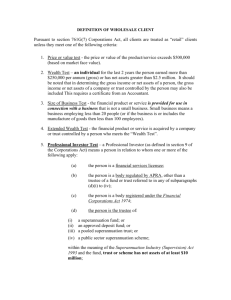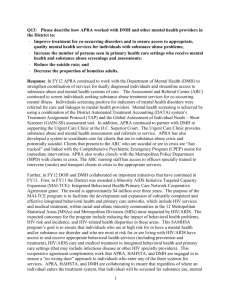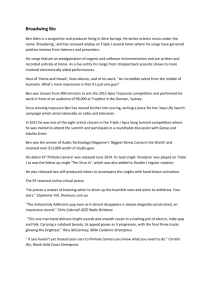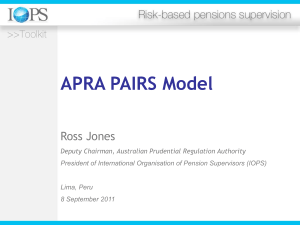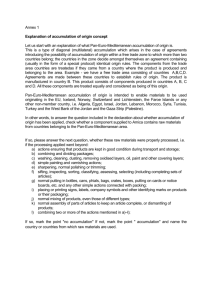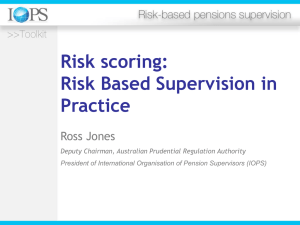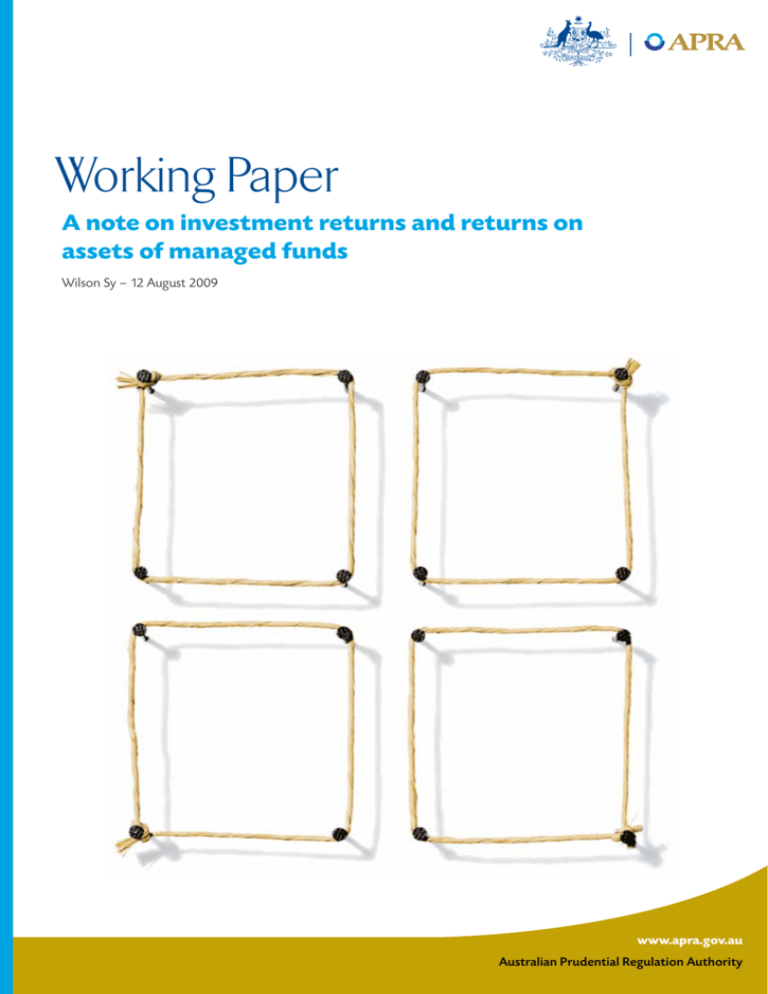
Working Paper
A note on investment returns and returns on
assets of managed funds
Wilson Sy – 12 August 2009
www.apra.gov.au
Australian Prudential Regulation Authority
Copyright
© Commonwealth of Australia
This work is copyright. You may download, display,
print and reproduce this material in unaltered form
only (retaining this notice) for your personal, noncommercial use or use within your organisation. All
other rights are reserved.
Requests and inquiries concerning reproduction and
rights should be addressed to:
Commonwealth Copyright Administration
Copyright Law Branch
Attorney-General’s Department
Robert Garran Offices
National Circuit
Barton ACT 2600
Fax: (02) 6250 5989
or submitted via the copyright request form on the
website http://www.ag.gov.au/cca
Disclaimer
While APRA endeavours to ensure the quality of this
Publication, APRA does not accept any responsibility
for the accuracy, completeness or currency of the
material included in this Publication, and will not be
liable for any loss or damage arising out of any use of,
or reliance on, this Publication.
Inquiries
For more information on the contents of this
publication contact:
Wilson Sy,
Policy Research and Statistics
Australian Prudential Regulation Authority
GPO Box 9836
Sydney NSW 2001
Tel: 61 2 9210 3000
Email: wilson.sy@apra.gov.au
A note on investment returns
and returns on assets of managed funds
WILSON SY1
Australian Prudential Regulation Authority
400 George Street
Sydney NSW 2000
Email: Wilson.Sy@apra.gov.au
Phone: 0612 9210 3507
12 August 2009
1
The author thanks Steve Davies, Katrina Ellis, James Cummings, Belinda Tracey and Cieran McBride
for helpful comments.
Abstract
This technical note proves a simple mathematical relationship between the return on
assets (ROA) of financial accounting standards and the return on investments (ROI) of
investment performance standards. We show why this relationship is needed by users of
APRA data to convert ROA to ROI for investment calculations such as for wealth
accumulation estimates.
Page 2 of 9
1. Introduction
For several years the Australian Prudential Regulation Authority (APRA) has been publishing
statistics of regulated superannuation funds. It has calculated a return on assets (ROA)
statistic as an indicator of the investment performance of different funds. The rationale
for the use of ROA was that it is a standard accounting measure for companies and other
APRA regulated entities on how efficiently the organisations are employing their assets to
generate earnings.
In this note, we explain why ROA is not the most suitable measure of return for wealth
accumulation calculations in compounding returns.
Instead we derive a simple
mathematical relationship that can be used to convert the existing ROA numbers to return
on investment (ROI) numbers, as recommended by the Global Investment Performance
Standards (GIPS). ROI is specifically designed to be compounded for wealth accumulation
calculations and may be a more useful measure of performance in superannuation funds.
2. Return on Assets
Financial statements of companies readily provide information about asset values and
earnings and they are relatively straightforward to interpret. Cash flow information,
however, is more difficult to interpret because the sources can originate, for example,
from earnings related payments and receipts of diverse company operations, as well as
capital expenditure, capital raisings or share buybacks.
Because corporate capital
activities are infrequent and usually small relative to total assets, the efficiency of
employment of assets can be conveniently estimated, in most cases, by the return on
assets (ROA).
The payout ratio of corporate earnings as dividends is mostly less than 80% and rarely
100%. Hence corporate earnings itself does not generally have a simple relationship to the
return to the investor, which consists of dividend income plus capital gains. In the
corporate setting, the return on assets is not used directly to estimate the return to the
investor and hence is rarely compounded to estimate long-run returns. Indeed, as we
explain here, it may produce inaccurate results when used for calculating wealth
accumulation for a managed fund.
If A0 represents total assets at the start of the accounting period, A1 the total assets at
the end of the period and E the earnings over the period, then the return on assets RA is
defined by the equation:
RA =
E
,
( A0 + A1 ) / 2
(1)
where the denominator is the average total assets over the period. The financial
quantities defined so far are related to the capital adjustments (cash flows) C by an
accounting identity:
A1 = A0 + E + C .
(2)
The equation expresses the simple fact that the change in total assets over the period
comes from earnings over the period and capital adjustments.
Page 3 of 9
2.1 Wealth accumulation calculations
For wealth accumulation calculations, we need to define an investment rate of return R
which relates starting total assets A0 to ending total assets A1 so that A1 = A0 (1 + R ) is
satisfied. This is the standard definition for the return on investments (ROI). Accuracy in
the investment rate of return is potentially important when returns are compounded over
many periods in wealth accumulation calculations. We now show that the return on assets
RA of equation (1) is not an accurate investment rate of return for wealth accumulation
calculations.
Eliminating E from equations (1) and (2) and carrying out some simple algebraic
manipulation shows
A1 =
A0 (1 + RA / 2) + C
.
(1 − RA / 2)
(3)
To simplify the argument for illustrative purposes, we consider first the case without cash
flows, because if the return of equation (1) is correct, it has to be correct for all values of
C , including the case where C = 0 .
In normal situations where RA < 2 and even more commonly RA 2 , we can expand the
denominator in equation (3) to get a relationship (for C = 0 ) showing how total assets
change due to earnings alone:
A1 = A0
⎛
⎞
(1 + RA / 2)
R 2 R3
= A0 ⎜1 + RA + A + A + ... ⎟ .
(1 − RA / 2)
2
4
⎝
⎠
(4)
Equation (4) demonstrates that the return on assets RA is not the most accurate measure
of performance for wealth accumulation calculations because A1 ≠ A0 (1 + RA ) , as seen from
the neglected higher order terms on the right hand side of equation (4). A more accurate
compounding factor would be the ratio in Equation (4) or the expression on the right hand
side of (4) including a sufficient number of terms.
2.2 Differences in estimates of accumulated wealth
Even though the neglected higher order terms on the right hand side of equation (4) are
generally small and, hence, the differences between the returns on investments and ROA
estimates are small for RA 1 , which is often the case, the differences can be substantial
when RA is not small or when small differences are compounded over many periods.
For example, if RA is constant over n periods, the ratio of accumulated wealth using
A1 = A0 (1 + RA ) to that given by equation (4) is
n
⎧ (1 + RA )(1 − RA / 2) ⎫
⎨
⎬ .
(1 + RA / 2)
⎩
⎭
(5)
For the case of a return: RA = 10% , the accumulation difference is about 0.5% per period
less than the more accurate R estimate; which compounds to about 9% for 20 periods and
Page 4 of 9
17% for 40 periods less than the R estimates. The differences increase as RA increases.
A simple, exaggerated and elementary (SEE) example shows how substantial differences
can occur when RA is large and when the condition RA 1 is not satisfied. Suppose
A0 = $100 and A1 = $200 which is a return on investments of R = 100% . However, if we
put these numbers together with E = $100 in equation (1), we find RA = 2 / 3 = 66.7% ,
rather than 100%. The accumulative difference from equation (5) is 5 / 6 which comes from
using RA to accumulate A0 = $100 instead of R. This results in ending assets of A1 =$166.67
instead of $200. Compounded over 20 periods, the accumulation would grow to $2,735,111
using RA and $104,857,600 using R, a difference of $ 102,122,489 which is significant.
We have shown that ROA given by equation (1) may be inaccurate for wealth accumulation
calculations. We have shown that the inaccuracy is due to conceptual differences and not
due to the effects of cash flows, because we have presented our argument for the case
where there are no cash flows.
3. Rates of Return in the presence of cash flows
Since the 1980s there has been a rapid expansion of the number of managed funds or
managed investment schemes, with more than 5,000 registered with the Australian
Securities and Investment Commission in 2008. There has been heightened interest in
comparing investment performance across different investment products. Historically,
different methods of calculating the rates of returns have been used in the industry.
The Q-Group (Sy et al., 1990) initiated a new industry discussion in Australia by publishing
a position paper on an investment performance measurement and attribution standard.
This work was subsequently carried forward by the P-Group (Solomon et al., 2002) in the
Australian Investment Performance Standards (AIPS) released as a guidance note by the
Investment and Financial Services Association (IFSA). Clearly, the globalisation of the
financial services industry has also made the use of international standards necessary.
Many countries including Australia are now conforming to the Global Investment
Performance Standards (GIPS) as published by the Chartered Financial Analyst Institute
(CFA Institute, 2005).
The two key aspects where the investment performance standards depart from normal
accounting standards are due to cash flow impact and the need for compounding in
multiple time span comparisons.
The ideal method of calculation of investment performance should allow for cash flows
into and out of the fund. This is because the timing and size of cash flows are largely out
of the manager’s control and they can have significant influence on the results of some
performance measures. The time-weighted rate of return evaluates the asset values of a
fund every time there is a cash flow and calculates a return since the last cash flow. The
total return over any given time period is a geometric linking or compounding of those
calculated returns. The time-weighted rate of return effectively factors out the impact of
cash flows and is an accurate measure of manager investment performance.
Secondly, investment performance comparisons are typically made over multiple time
spans e.g. quarterly, yearly, over three, five, seven or ten years. Due to this requirement,
time weighted calculations are necessary for reasons of accuracy and consistency over
multiple periods.
Page 5 of 9
However, taking account of every single cash flow would be a difficult and onerous task.
Frequent asset valuations are often impractical in many situations, such as for
superannuation funds, which may contain illiquid assets which are not frequently valued.
In those cases, the recommendation by GIPS is to use the money-weighted rate of return
for the period taking into account all information available for the cash flows.
The money-weighted rate of return over a given period is the internal rate of return which
takes into account the timing of all cash flows over the period. For example, if a cash
flow occurs near the beginning of the period, it will have more impact on the estimated
returns for that period than if it occurs near the end.
When measuring performance over one year for a typical institutional superannuation fund
there are many contribution and benefit payments during that time. In the absence of
detailed information about the timing of each cash flow, we assume that cash flows are
spread evenly over the period and that the money-weighted return can be approximated,
when small, by a simple formula for the internal rate of return. The standard moneyweighted return on investment (ROI) RS in conformance to GIPS is
RS =
E
.
A0 + C / 2
(6)
The meanings of the symbols are the same as those for equations (1) and (2).
The
weighting factor 1/2 is due to our assumption about the evenness of the cash flows. The
factor theoretically can have any real value on the closed interval [0, 1]. Dietz (1966)
provided one of earliest discussions on this formula. If the cash flows are weighted closer
to the beginning of the period then the factor is closer to 1 and decreases towards 0 as
cash flows are weighted towards the end of the period.
From equations (2) and (6), the value of total assets at the end of the period is given by
A1 = A0 (1 + RS ) + C (1 + RS / 2 ) .
(7)
Evidently, the starting assets are employed for the whole period and therefore increase by
the factor (1 + RS ) , whereas the weighted cash flow is employed for only half of the period
and therefore increases by the factor (1 + RS )1/2 , which is approximated here by the factor
(1 + RS / 2) . In other words, the standard money-weighted formula (6) can be derived as
the solution to the approximate version (7) of the equation for the internal rate of return.
In the absence of cash flows, we have C = 0 in equation (7) and A1 = A0 (1 + RS ) . Thus this
relationship is what we normally use for compounding returns for wealth accumulation
calculations. If RS is constant then after n periods the total assets are given by
An = A0 (1 + RS ) n .
(8)
Note that the purpose of the approximation (6) is to compensate for the impact of external
cash flows on investment earnings. The estimate of the long-term return is given by
equation (8), when there are no interim net cash flows due to contribution and benefit
payments.
If there is a constant cash flow C ′ at the end of each period, then due to the annuity
Page 6 of 9
stream, instead of (8), the accumulated value can be shown to be given by
An = A0 (1 + RS ) n +
C′
{(1 + RS )n − 1} .
RS
(9)
If the constant cash flow C ′ comes in the middle of each period, instead of at the end of
each period, then the formula (9) is only slightly more complicated, with C ′ being replaced
by C ′(1 + RS / 2) .
4. Relationship between ROI and ROA
Since we have two formulae for the value of the total assets at the end of the period:
equation (7) given in terms of ROI, the standard rate of return RS , and equation (3) given
in terms of ROA, the return on assets RA , it should be possible to derive a relationship
between RS and RA . Indeed, from equations (1), (2) and (6), on eliminating A1 , we find
RS A0 + ( E + C ) / 2
R
=
= 1+ S .
RA
A0 + C / 2
2
(10)
From this, the return on assets RA can be expressed as a mathematical identity, entirely
in terms of the standard rate of return RS , for any values of A0 , E or C :
RA =
RS
.
1 + RS / 2
(11)
Equation (11) shows that except for zero return, the return on assets RA is always less
than the standard rate of return RS for real values. Table 1 gives a small numeric sample
to illustrate the relationship. Note that the differences are greater for negative returns in
bear markets.
Table 1: Sample return on investments
vs. return on assets
RS (%)
RA (%)
-25
-20
-15
-10
-5
0
5
10
15
20
25
-28.6
-22.2
-16.2
-10.5
-5.1
0.0
4.9
9.5
14.0
18.2
22.2
Page 7 of 9
Going
back
to
the
SEE
example
in
section
2.2,
we
have RS = 1 = 100% ,
giving RA = 2 / 3 = 66.7% . This is a difference of 33.3% , as we have already observed.
The converse relationship for finding the rate to use for compounding RS given the return
on assets RA is
RS =
RA
.
1 − RA / 2
(12)
This relationship is noteworthy for users of APRA statistical data, because APRA has
historically provided only return on assets as the measure for investment performance.
While relative performance based on ROA comparisons remains valid from period to period,
multi-period comparisons require instead the use of industry standard rates of return.
Equation (12) provides the bridge to convert APRA data to industry standard data for
calculating wealth accumulation.
It is important to note however the relationships of equations (11) and (12) are only valid
for the money-weighting with a factor ½ we have used in equation (6) which was based on
the assumption that cash flows occur evenly during the period. It is not valid for more
general money-weightings where the factor differs from ½. But since most cash flows
(regular contributions and pension payments) of superannuation funds tend to occur evenly
throughout the year, our relationship has wide applicability, certainly for the data we have
been dealing with at APRA.
APRA is moving towards using this industry standard rate of return (6) for performance
measurement of superannuation funds rather than the ROA. Another adjustment which
will be made by APRA is to take into account liabilities which sometimes exist for
superannuation funds and which are generally small and unintentional. In this case, in
place of equation (6), we incorporate liabilities L0 in the definition for return on
investment:
R=
E
.
A0 − L0 + C / 2
(13)
Unfortunately, there is now no simple relationship such as equation (12), connecting R
simply to RA , the return on assets.
5. Conclusion
We have shown mathematically that the return on assets used in financial accounting to
measure corporate capital efficiency is not the most accurate measure for investment
application purposes, such as for calculating wealth accumulation. Some users of APRA
data may not fully appreciate this inaccuracy in their applications.
However, we have demonstrated a simple mathematical relationship that may be used in
certain circumstances to relate the return on assets to the rate of return used widely as
the industry standard. This enables the substantial amount of APRA data on returns on
assets to be converted easily (without additional data) for use in more accurate wealth
accumulation calculations.
Page 8 of 9
6. References
CFA Institute (2005): “Global investment performance standards”, Chartered Financial
Analyst Institute publications, February 2005. Available online at
http://www.gipsstandards.org/standards/current/index.html
Dietz, P.O. (1966): “Pension fund investment performance – what method to use when”,
Financial Analysts Journal (January-February), pp. 83-86.
Solomon, G. et al. (2002): “Australian investment performance standards”, IFSA Guidance
Note No. 1.00, Investment and Financial Services Association.
Sy, W. et al. (1990): “Investment performance and attribution standard”, Q-Group position
paper, Institute for Quantitative Research in Finance.
Page 9 of 9
Telephone
1300 13 10 60
Website
www.apra.gov.au
Mail
GPO Box 9836
in all capital cities
(except Hobart and Darwin)
SA_WP_IRRAMF_082009_ex
Email
contactapra@apra.gov.au

